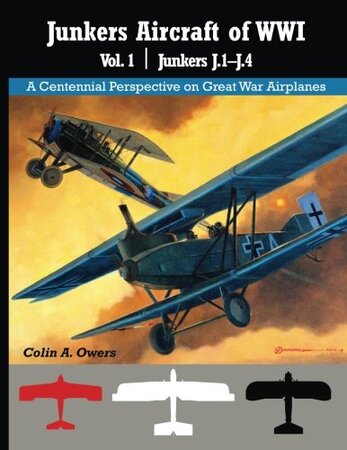
Junkers Aircraft of WWI, Vol. 1, Junkers J.1-J.4
By Matt Bittner
Author: Colin A. Owers
Publisher: Aeronaut Books
ISBN #: 978-1-935881-65-0
Binding: Softcover
Pages: 208
Professor Hugo Junkers was an aircraft producer ahead of his time. In an age of all-wood, canvas-covered aircraft he decided that making all-metal airframes was the way to go. There were two inherent problems, though. First was how to mass-produce these aircraft. Secondly, and an even bigger stumbling block, was convincing the powers-that-be that aircraft made all of metal was the way to go.
This volume covers the first four of his designs, the J.1, J.2, J.3 and J.4, which were internal Junkers designators. There was only one J.1 made but that led to the somewhat more successful J.2, of which six were produced. While the J.2 had decent performance, because it was completely made out of steel it was quite heavy and sluggish.
The J.3 was nothing more than a project that never made it past the first few stages of design, but the more successful J.4 - known in the military as the J.I (upper-case 'eye' and not the number 'one') - was produced in higher numbers and served its purpose well as an armored reconnaissance aircraft. There are many photos in this book showing aircraft shot up - some with as many as 100 holes in the airframe - and still made it back to the German lines, keeping the crew safe.
Having recently acquired the RSS Hobbis 1/72 kit of the J.2 I found this book a must for helping construct that model. In fact I can recommend this book if you're building any of these first three (the J.3 not being finished) Junkers designs as models. Speaking of models, there were three 1/72 kits produced of the J.2 prior to the RSS Hobbis kit (Merlin Models in injected plastic; Blue Rider/Phoenix in vaccuum-formed plastic; and in resin from Classic Plane) and Eduard produced a 1/72 plastic injected kit of the J.4/J.I (known as the Tin Donkey), now unforunately out of production. In 1/32, Wingnut Wings did a kit of the J.4/J.I. There are no known models of the J.1.
I really enjoyed reading this book. It shed light on the advanced designs of the Junkers planes and the trials and tribulations he went through while producing them. With the high resolution of the photographs and Juanita Franzi's color profiles, this is the "go-to" book when dealing with the first four designs of Junkers. I'm looking forward to reading Volume 2.
